How does a common house heat meter work. Is it profitable to install an individual heat meter in an apartment and how to do it right
"Gold" counters
In Nizhny Novgorod, residents of apartment buildings continue to discuss the problem of installing common house heat meters.
The residents, to whom these heat metering devices cost more than half a million rubles, are outraged, the FAS Department initiated a case against Teploenergo on the grounds that the cost of installing meters was overestimated. In turn, thermal power engineers assure that the incident occurred only because the houses turned out to be atypical.
It all started with the fact that residents of house number 42 on Gordeevskaya Street in Nizhny Novgorod turned to the regional antimonopolists. The cost of the metering device installed in the basement of this house amounted to 661 thousand 525 rubles. Residents were asked to pay this amount in equal installments over a period of five years. It was proposed to share how much to whom to pay in proportion to the areas occupied by residential and non-residential premises.
We calculated the cost of the meter, guided by the logic of Teploenergo specialists and according to their criteria, - Alena Suvorova, press secretary of the Federal Antimonopoly Service of Russia for the Nizhny Novgorod Region, commented on the situation. - Our experts came to the conclusion that the average market price of such devices is about 245 thousand rubles. Teploenergo's pricing policy is currently being tested.
Heat power engineers have their own view of the problem and their own truth. They emphasize that the cost of installing meters was discussed by expert and public councils under the FAS Department.
For a typical nine-story building with a living area of 4-5 thousand square meters, the cost of installing common house metering devices by the company, taking into account the rise in price with a five-year installment plan, amounted to about 450 thousand rubles, - said Vladimir Kolushov, General Director of Teploenergo. - Among the houses, according to the appeals from which a case was opened to the FAS, there is a house that represents one extreme: a huge one, with an area of over 20 thousand square meters, while having one input and, accordingly, minimal costs for installing an accounting system. There is another extreme: Narodnaya, 38. If we solve the problem for this single house, then the price per square meter would be equal to 11 rubles. We understand why residents have questions. But we still cannot understand the position of the OFAS.
The head of "Teploenergo" also complained that the OFAS, considering the appeal from the residents of a particular house, does not take into account the fact that the heat supply organization has a very large-scale task - to equip 1800 houses with metering devices.
 Thermal power engineers consider the existing pricing scheme to be the most fair for all residents and the least costly for them. They also remind that the meter supplier was selected during an open competition held by Teploenergo. Its winners were a manufacturer from Arzamas and a leasing company owned by a large bank with state participation in the capital.
Thermal power engineers consider the existing pricing scheme to be the most fair for all residents and the least costly for them. They also remind that the meter supplier was selected during an open competition held by Teploenergo. Its winners were a manufacturer from Arzamas and a leasing company owned by a large bank with state participation in the capital.
We are absolutely confident in our position on how all the work has been carried out, and there is no doubt that the total amount of costs that we re-charge to residents is in line with market indicators. But at the same time, we are aware that in the context of individual houses there are deviations both up and down. It will be erroneous to calculate the price, taking into account the cost of installing a metering station on a specific house. The principle by which the payments were calculated is based on the area of the house, which is why the price per square meter is acceptable for all owners, Vladimir Kolushov noted. - I want to emphasize another aspect - the monthly payment of consumers for installed appliances accounting is fixed and amounts to 1.7 rubles per square meter of apartment area. Despite the fact that, among other parameters, the area best reflects the possible cost estimate for installing common house appliances in a given house, in each case it may not coincide with the costs that the owners of this house would incur if they installed the meter on their own.
In turn, the OFAS specialists are sure that residents of more than one house are dissatisfied with the cost of metering devices chosen by Teploenergo.
From July to November, the OFAS received 53 complaints from residents who considered that the prices for common house heat meters installed in their homes were overpriced, said Mikhail Teodorovich, head of the OFAS Russia for the Nizhny Novgorod region. - We have created a special commission, it will have to figure out whether there has been a violation of the federal law. If we establish the fact of a violation, most likely, Teploenergo will have to pay a fine. Then residents can demand the abolition of fees for meters.
According to the FAS, the natural monopoly position of Teploenergo determines its responsibility and obligation to comply with legislation both in the field of heat generation and distribution, and related to pricing. However, it should be noted that residents of only four out of 1800 houses serviced by the company have claims against thermal power engineers.
Is there any benefit from transferring an apartment building to the metered heating method? What is the principle of calculating the payment for heat? How to actually get real savings? These topical issues for our country require detailed consideration.
It’s worth starting with one explanation: the heat meter does not directly reduce resource costs. It only counts the incoming thermal energy. In the case when the house has good thermal insulation, the windows in the entrances are intact, the windows in the apartments do not see through, the facade is closed with expanded polystyrene foam or basalt wool, and the windows and doors are not wide open, then the installed unit will bring you lower heating bills.
If a high-rise building is poorly insulated, batteries in the entrances heat the street, and the tenants do not take care of the insulation of the windows, then the bills for the supply of thermal energy may be higher than before.
For residents, it may be a good option to install a heating meter in their apartment. Since the summer of 2012, all heated buildings in Russia are required to have such meters. Therefore, it does not matter what condition your house is in: there must be a heat meter in it.
Who benefits from these whole-house appliances? Why was Federal Law 261 adopted? Consider the key points of this question:
- To ensure that the payment for heat is divided fairly among the owners of houses. Simple situation. In one house, the owners carried out expensive thermal insulation measures, while in the other they decided to save money on this. For this reason, it is not right to demand the same payment from them for the supply of thermal energy. This argument is most liked to bring employees of housing and communal services.
- An attempt to force the tenants of high-rise buildings to save heat in their home. This argument sounds more eloquent. Persuasion on our citizens is no longer valid, but they know how to count money. If they are taught that an unclosed door or window will result in additional expenses for them, then the tenants will begin to carefully monitor this.
- The most unpleasant moment for those who consume housing and communal services: Federal Law 261, which has come into force, clearly states that the responsibility for the safety of common property in the house now lies on the shoulders of residents.
In the past, the procedure for calculating fees for heating attics and basements was as follows: they were calculated on the basis of the total heating bill with reference only to the existing tariff. It was necessary for the management company to maintain and monitor the performance of the common house property. And do it for a fixed fee.
The principle of performing the calculation of thermal energy
Several options are possible here. First option: if the apartment does not have individual heat meters. Such a picture is common for buildings that were erected in pre-capitalist times. Most of these buildings, located in the former Soviet Union, use riser heating. If such devices are mounted in them, then on each radiator in each room. Which will cost a decent amount.
First, calculate how much heating costs 1 sq. m. The received heat, which was recorded by metering devices, at current prices, is divided by the total area of \u200b\u200ball the premises heated in the house. The payment of a separate apartment for common house property will depend on its area. After that, you need to sum up the area of \u200b\u200bthe apartment and the shares in the common property, and then find the product of the obtained value and the heat energy tariff.
Second option: The apartment has its own heating meter. Modern buildings are mainly built with the creation of a horizontal thermal circuit inside individual apartments. He 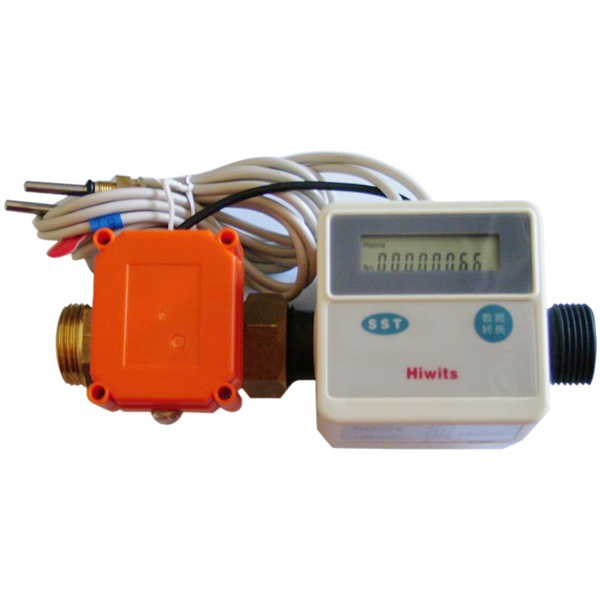 departs from the common riser. This situation makes it easy to mount individual heat meters. The calculation principle is as follows:
departs from the common riser. This situation makes it easy to mount individual heat meters. The calculation principle is as follows:
- You pay for the heating of your premises according to the indications of an individual meter, which is a logical and predictable decision.
- The amount of energy that goes to heating entrances, attics and basements is equal to the difference between the readings of the common house and all intra-apartment meters.
- Your contribution to the heating of common areas will be calculated in the same way as the previous option. It will depend on the area of the apartment you own.
Third option: payment for heat in the case when there are no metering devices in your apartment, but other owners have them. The principle of the calculations will be simple and clear:
- The readings of all installed meters (internal and common house) are taken.
- A fee is charged to owners who have metering devices. This amount is subtracted from the total readings. As a result, we have the cost of heating common property and apartments, where they did not dare to install metering devices. Calculate the cost of heating 1 sq. m. They charge for an apartment without meters, according to their area, as well as for entrances, basements and attics, according to the available share.
Meters and savings
The installation of devices does not yet guarantee a real reduction in the service fee. What needs to be done to reduce the amount in payments? Having mounted, apartment metering devices, in conjunction with control valves, you will receive and pay exactly as much as you need.
With this approach, your dependence on the actions of housemates will be lower.
A practical scheme for installing heating meters:

What actions can be taken by the owners of premises equipped with a standing heating system? Installing equipment that regulates the supply of coolant to each battery is very expensive. Such a project is unlikely to pay back the initial investment. Do not forget about the need for regular maintenance of these facilities. The owners can help the installation of electronic thermometers. They are also called heat distributors. It produces a permanent record of the temperature of the air and the surface of the battery.
The cost of such a device is low (about 1000 rubles). You need to mount it directly on the radiator. There will be a good incentive to save heat, since payment will be for the resource actually received.
The problem of centralized heat supply networks is that no matter how hard the apartment owners try to insulate their homes, they will not be able to pay for the amount of heat actually consumed until a common house heat energy meter is installed and legalized. Through various energy-saving measures, it is possible to achieve an increase in the temperature in the premises, but not adequate payment to the service provider. About the role played by house and apartment heat metering units, their varieties and installation procedure will be described in this material.
On the importance of accounting for consumed heat
Already from the introduction, we can conclude that any measures to reduce energy consumption should begin precisely with the accounting of energy consumed. The scheme, in accordance with which payment for heat is charged, until recently was the same in all countries of the post-Soviet space and was inherited from the USSR. The principle is simple: the supplier organization introduced an approved tariff per 1 m2 of premises, which includes all costs, losses during delivery and profit of this enterprise.
Heat metering in an apartment building is needed in order to have an idea of the real heat consumption and pay accordingly. Having a common house node, you can safely proceed with the modernization of the building. The improvement in thermal characteristics will necessarily affect the heat consumption and will be taken into account by the devices. In addition, the introduction of the node will cut off heating networks, for losses in which earlier they also had to pay, they were taken into account in the tariff.
As a rule, the installation of metering devices provides financial savings for residents in the amount of 25 to 40%.
Who installs a common house heat meter?
The answer to this question depends on the legislative acts in force in a particular state of the post-Soviet space. If you take Russian Federation, then there is already a decree stating the installation of such metering devices without fail. At the same time, the task is entrusted to organizations that supply heat to houses. Maintenance and verification of common house devices for metering heat energy falls on their shoulders until the tenants create their own association of co-owners (OSBB).
Note. Organizations take on a considerable cost of equipment and its installation, but compensate for these costs by collecting additional funds from all residents over several years.
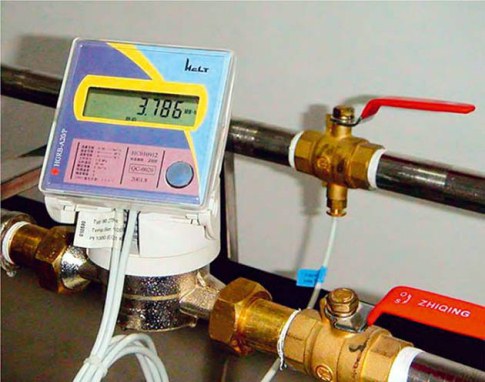
The issue in Ukraine is not so categorical. There, individual heat meters are installed for the whole house, entrance or apartment at the request of residents and completely at their expense. The meeting of co-owners appoints a responsible person whose task is to:
- obtain permission from the heat supply organization;
- conclude a contract for design work with a licensed company;
- guided by design solutions, determine the cost of equipment and installation;
- to raise funds;
- coordinate project documentation with the heat supplier;
- purchase equipment and hire a contractor for its installation;
- put the object into operation.
Note. The heat supply company sets the term for verification and maintenance of devices in accordance with regulatory documents. In other CIS countries, there is approximately the same procedure for installing and legalizing heat energy metering devices.
Heat meter for the house
Regardless of the type of flow meter units, the principle of their operation is the same and looks like this: an electronic calculator collects data from 2 sources - a flow meter built into the supply pipeline and temperature sensors. Based on these data, the calculator calculates the consumed heat and displays the result on the display. Additionally, it can send data via GSM channel (mobile communication) or via the Internet directly to the service provider's dispatcher.
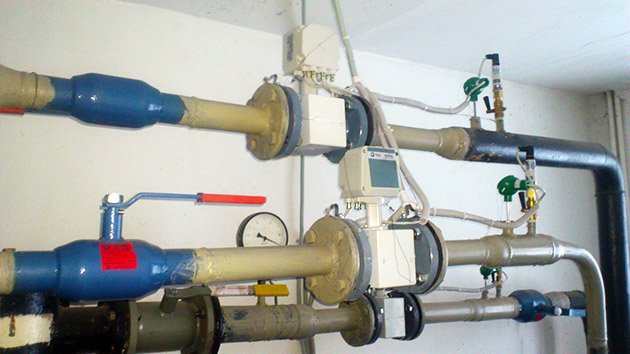
Note. More complex and accurate metering units use 3 sources instead of two, the third is pressure sensors.
House individual heat energy metering devices are used in 3 main types:
- turbine (tachometric): they measure the amount of flowing coolant using a mechanical impeller located inside the flow;
- ultrasonic: measure the flow rate of the coolant based on the speed of passage of water by ultrasound;
- electromagnetic: the flow velocity is determined by changes in the magnetic field created around the measured area.

Turbine flowmeters, although cheaper than others, give the greatest error. It also requires periodic filter cleaning and frequent maintenance. They create hydraulic resistance to flow and are very sensitive to the presence of suspended solids in the coolant, and therefore are now rarely used.
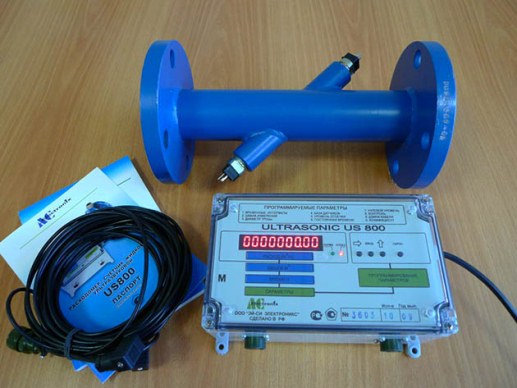
Ultrasonic devices are more expensive, but they are more accurate and reliable in operation. They do not require frequent maintenance and do not create resistance, but they need a straight measured section of a certain length before and after themselves. If the water in the pipeline is too dirty, the measurement error may increase. Electromagnetic flowmeters can also respond to water quality, but not significantly, and they do not need straight measuring sections. These devices are most often placed on the common house inputs of the heating network.

For reference. Sometimes the coolant is supplied to an apartment building by a through collector, which goes further to the next buildings. Each entrance has its own heating point and tie-in to the collector. It turns out that it is necessary to install not one node, but two, - at the entrance of the collector to the house and at the exit. An alternative solution will cost less - an individual heat energy meter is installed on each entrance.
Individual heat meters
Payment for the supply of heat energy with a common house meter installed is made according to the old scheme: the accrued amount is distributed to all apartments in proportion to the area. This distribution does not suit everyone, because some have insulated walls and have energy-saving windows, while others still live with old wooden ones. The owners of insulated apartments have invested in their modernization, making them pay on a par with the rest is not entirely fair.
![]()
For these reasons, many users are interested in their own heat meters in the apartment. Their installation does not require OSBB registration and other formalities. The main thing is to develop a project, install the device and coordinate all your actions with the service provider company. Unfortunately, this option is not available to most apartment owners, and here's why.
Energy metering implies the presence of a single source of energy, and in most apartments there are several thanks to a vertical heating system. It turns out that it is necessary to put the device on a tie-in in each riser, which is insanely expensive, it is easier to pay according to the old scheme. Options with the reconstruction of the vertical scheme are as complicated as they are unpromising, because they threaten to unbalance the system. And only in newly built houses where a horizontal heating system is installed, you can safely mount an individual apartment meter.
Happy owners of housing with horizontal branches can purchase a kit corresponding to the diameter of the pipes and mount it at the coolant inlet to the apartment. Having an approved project, documentation and a certificate for the meter in hand, you can register it with the managing organization and switch to postpaid services. Below is a diagram of the installation of an apartment metering device:

Recently, so-called overhead meters have appeared on sale, designed to account for the heat expended by each radiator. Their price is relatively low and it is quite realistic to buy a device for each battery. Another thing is that the service provider organization is unlikely to want to deal with such meters and refuse to register them.

Conclusion
Metering units by themselves do not save thermal energy. But they allow you to clearly control its costs and thus open the way for thermal modernization of the building, individual adjustment of the heating system and the introduction of automation.
Is it possible to put counters on heating? Counters are connected exclusively for rational reasons. Why pay for heating in full if the apartment was cold for some time? In order to save money, meters are being installed. The installation process costs a lot, but in the future it will not allow you to take extra finances to the state treasury.
Thus, the payment for utilities is calculated according to the installed appliances.
Heating meters are installed by specialists or with their own hands.
They are divided into 2 types: devices installed on a communal pipe and private. In the first case, the devices are called common house, in the second - individual heating meters, that is, they are installed in the radiator directly in the apartment or private house at the request of the owner.
General building heating meter: device features
General house heating meter.
Such a device is used in residential buildings. At a meeting of residents, the issue of installing a common house heating meter is decided - a common device has a number of advantages over an individual meter. Firstly, a common house meter will be much cheaper. Secondly, the readings of the device will be calculated in accordance with the number of residents, that is, you do not have to pay so much. The responsible person, who is selected at the meeting, pays for this utility service. This person is also responsible for purchasing the meter. A common house meter is much more expensive than an individual type of device, but if divided equally between residents, it will turn out to be profitable.
A common house counter can be installed with your own hands. To do this, you need to connect it to the central pipe, which, through the house collector, provides the house with heating. The second installation method is installation in the return line. This pipe removes the waste type coolant from the radiator. Both methods of connecting the device are not characterized by the complexity of the work.
The radiator, inside which the heat exchange process is regulated, is at the same time a device for connecting the meter. To avoid problems during its installation, invite a specialist. However, you will have to pay an additional amount for the services of the master. A common house heating meter is installed in the radiator: this way it will be easier for you to take readings.
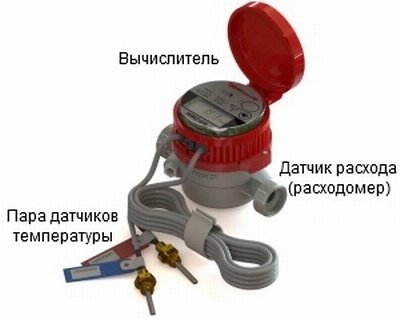
The device of the heating common house meter.
An individual type counter is bought and installed in the apartment by the owner. He pays for everything: the device, the services of the master, receipts. That is, the heat meter belongs to him personally, he is fully responsible for it. An ordinary such device is an ideal solution in case of refusal of a common house meter. The presence of this device greatly simplifies your life: so you will be calm for the honesty of paying for heating. Therefore, it is necessary to install a heat meter, even if the neighbors are against the common system.
There are some difficulties in installing an individual meter. For example, if the wiring in your house is vertical, then the work scheme takes place in several stages, since there is no central part of the heat supply. That is, it is necessary to introduce a riser into all rooms of the apartment.
The problem is solved by attaching the heat meter to the radiator. The radiator regulates the process of heat transfer, and the fixed device regulates the amount of heat produced. At the same time, the counter works efficiently and for a long time. The price of a heating meter in an apartment is much more expensive, since it is considered more reliable and has a guarantee from the manufacturer.
Installing a heating meter
Any installation work of the heating system (including the installation of a heat meter on a battery) is carried out only by specialists. To start installing a heating meter, you will need:
- Order a device installation project.
- Coordinate the package with documents for permission to install with public utilities.
- If the commission approves, then the project is implemented and heating meters are installed in the apartment.
- Register the meter with the public utility (otherwise it is considered invalid), after which it is given for use.

Scheme of installation of meters in the apartment in the heating system.
After the above procedures, you can call specialists. They must:
- Implement this project.
- Coordinate documentation on heat supply matters.
- Install a meter.
- Officially register the device.
- Hand over the heat meter for use and transfer it to the jurisdiction of the supervisory organization.
Any counter must have a passport and a certificate. The documentation indicates the period for the first verification of the device by the manufacturer.
This period is also indicated on the device itself in the form of a stamp. During the use of the heat meter, it is necessary to check its operability. Verification of meters is done depending on the model of the device. It usually takes place every 4 years.
After the expiration date on the brand, you should contact either Rostest at the place of residence, or an organization that specializes in checking meters. Manufacturers should also check the devices (as a rule, each company has a service).
How to pay for heating on the meter? To pay for utilities, you should look at the figure shown on the device. Next, fill out the receipt, in it you will see the difference between the current and previous readings. At the end, multiply the number on the meter by the current tariff and pay for thermal energy.
The principle of operation of the heat meter
This device has 2 sensors, one of which is called a flow sensor, the second is called a temperature sensor. The task of the first is to calculate the amount of heating consumed, the second is to measure the temperature. The main part of any meter is the heat meter. This is a kind of calculator, it gives the results of the count. To do this, the amount of heating consumed by the meter is multiplied by the temperature. Thus, you receive readings from which you then pay.
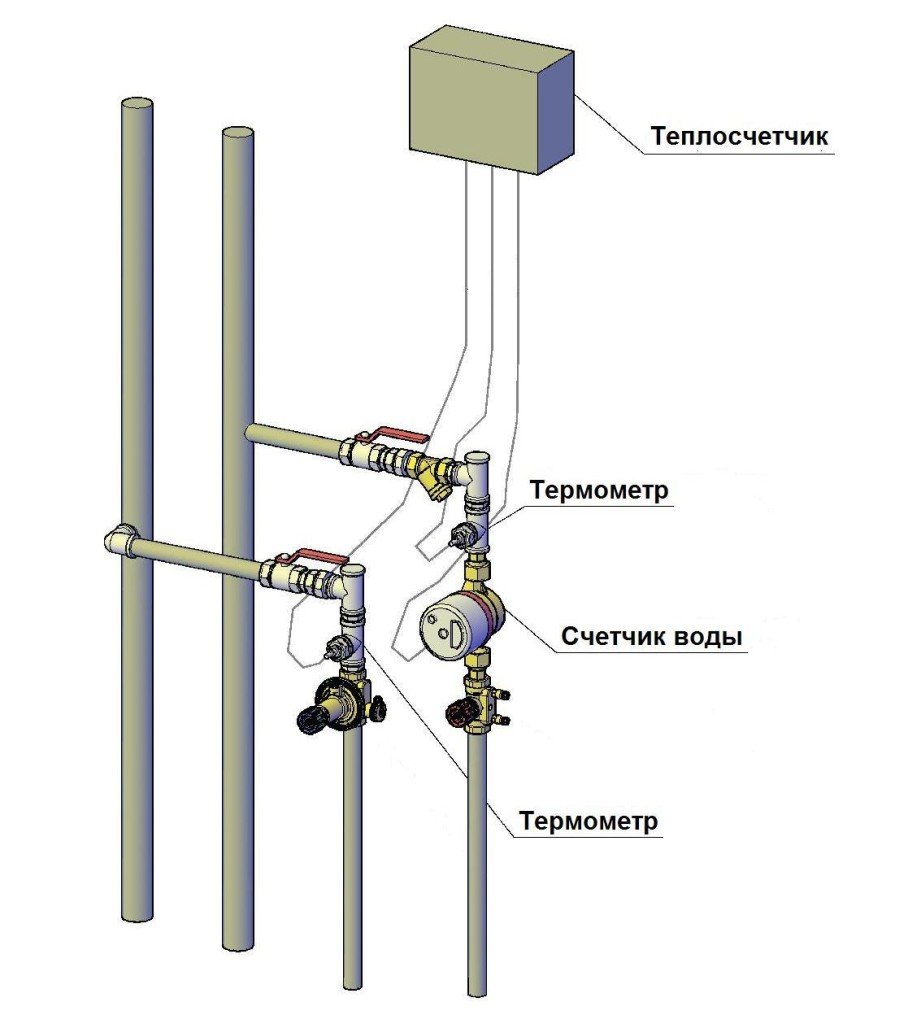
Installation of a heat meter.
Verification of counters. Verification must be performed once every 4 years. The purpose of this procedure is to determine the suitability of the device. The verifier must make an appropriate note in the passport of the device and issue you a certificate, which will be a confirmation of the meter's performance.
How to choose the right heat meter for heating?
Devices for determining the consumed heat are of 4 types: mechanical device, ultrasonic, vortex and electromagnetic. Depending on the conditions of use, one of them is installed. Mechanical heat meters are considered the simplest in technical terms. The scheme of their work is based on changing the movement of the coolant of a translational nature to the movement of the measuring device. There are several types of such devices: turbine, screw, vane. The mechanical counter is affordable, which gives it an advantage over other devices. However, it is not recommended to use it if the water in the coolant is hard, with the presence of scale and rust. The device becomes clogged quickly, requiring immediate cleaning. To avoid this, special filters are installed.

Installation of a common house meter by employees of the housing and communal services.
Ultrasonic heat meters are able to measure the time that the liquid in the heat exchanger passes from the source to the signal receiver. This type of device is durable and reliable. Works exclusively in clean water, without impurities and precipitation. If scales, bubbles and scale appear in the coolant, then there is a distortion in the measurements. That is, its benefit is equated to zero. Such counters need to be checked as often as possible, so you will extend their service life. Ultrasonic counters are frequency, time, correlation and Doppler.
The vortex type heat meter is a device that can be installed on a horizontal and vertical radiator (its pipelines). Vortices serve as an evaluating device. They are formed due to an obstacle on the way to the coolant. Such devices are sensitive to air, welding and the presence of impurities in the water. Therefore, a filter is required. However, various deposits in pipelines do not interfere with the performance of the meter, which is one of the advantages of such devices. Vortex meters are demanding on the size of the pipeline, so the devices are purchased in accordance with the parameters of the pipes.
An electromagnetic meter installed in an apartment works on the principle of the appearance of current at the moment when water passes through a magnetic field. The devices have metrological stability, that is, they are safe in operation. The readings become inaccurate if the radiator is filled with liquid with impurities or the wires are poorly connected during installation.
How to choose a company to install a heat meter for heating?
The company to which you can apply for the installation of such devices must meet the following requirements:
- Departure of employees should be free, with the necessary recommendations.
- Specialists are only qualified, with work experience. There is a specific scheme of work and equipment for installation.
- The firm must have documentation that confirms their activities. They may also provide certificates, certificates or SRO approvals.
- Registration in the Unified State Register of Legal Entities.
- Providing guarantees for work.
- It is desirable to have benefits for pensioners and the disabled.
- Form of payment for their services. Possibility of installment.
- Implementation of the subsequent dismantling of meters.
Now you know what the counters are for, what they consist of, the principle of operation of these devices. You also got acquainted with the types of heat meters and their technical characteristics, methods of installation and payment for heating. Therefore, you can purchase such a device in an apartment, it will bring you considerable benefits.
Today, residents are increasingly concerned about utility bills for heating and hot water. Frankly, these are very large sums, which can reach more than a million rubles for multi-entrance residential buildings.
To solve this problem, to reduce heating bills, residents of houses began to install common house meters. A couple of years ago, a law was passed that a meter should be installed in every multi-storey building. The exception was houses in poor condition. This innovation caused a lot of questions among the residents of the houses: someone agrees to install a meter, and someone does not. The main reason for the refusal was that you need to pay for the meter with your own money. It is necessary to figure out whether these meters will really save money for residents, how long their service life is.
Advantages of a common house meter
In recent years, the issue of savings has become very acute. Many residents try to count everything, recalculate, so as not to pay extra kopecks and not be in debt. When a meter is installed in the house, residents begin to think about the importance of saving. The meter itself does not reduce the amount paid for heating, it only records all the resources used. Many residents of high-rise buildings have had conflicts with the new adopted law on the installation of meters. To avoid questions about the law, here are its main objectives:
- True and reliable heating bills. If a common house metering station is not installed, then the residents of the house pay according to the total estimated load, which is usually overpriced. In this case, residents who are worried about heat and have installed a meter will pay several times less.
- Increase the share of responsibility for other residents of the house. Only together can we achieve a common result - low heating prices. Everyone should be motivated to save. Otherwise, if someone saves, but someone does not, then the bills will remain the same.
- Account control. Savings directly depend on the condition of the house. If the house is insulated, there is an iron entrance door, which is always closed, the windows are not broken, then it makes sense to put a meter and save. And if the opposite is true, then first you need to take care of the condition of the entrance and the house as a whole. Make sure that the door to the entrance is always closed, the condition of the windows. In general, it is necessary to monitor the insulation of the house. This is the only way people can save money.
Cons of general house accounting
Like any device, the counter has disadvantages. The most important thing is that you have to pay for its purchase and installation out of your own money. And that's a pretty big amount. But the more apartments in the house, the less everyone will have to pay. In addition to the purchase, you will need to find an organization that will install the meter, keep records of it, and repair the meter. Of course, it must be a reliable company that will not deceive, will do the job efficiently and for a reasonable amount.
Among the disadvantages of common house meters, one can single out the fact that each individual apartment will not be able to save money, because we are talking about a collective heat meter. If a resident reduces heat consumption, this will not save him from paying his heating bill. For this method of saving, individual apartment heat meters are needed. Of course, their installation is quite real, but it costs much more money, because such meters must be installed in every apartment! Otherwise, the calculation of apartment heat meters is not possible. The principle of operation of this counter is how much you used, so much you paid. In houses where the heating system is organized horizontally, an individual meter can be installed there. And in houses with a vertical system, only common house meters can be installed.
If you want to order work on the organization of heat energy metering in the complex, then the employees of our company:
- draw up technical specifications and approvals;
- make all project documentation for the heat meter;
- coordinate documents with communal organizations;
- install the counter and do all the necessary work on it.
A common house meter really reduces heat bills by up to 35% and pays for itself in about 3 years. But counters are also different. Although they have the same function, they work in completely different ways. If all the tenants of the house are set to save money and work together to achieve this, then bills with a small amount will not be long in coming.
Types of common house meters
Tachometric meters - consist of a mechanical water meter and temperature and pressure sensors.The disadvantage of this type of meter is that it cannot be used in homes where the water is hard. And in many houses this is the water. This leads to the fact that the impeller becomes clogged and the counter stops working. Such meters are most often installed in private homes. And they are almost never used to calculate heat for heating, but such devices can be used to account for hot water or drinks.
An ultrasonic meter is of good quality, reliable accounting, however, the range of flow measurement with a normalized error is less than that of electromagnetic meters, and moreover, longer straight sections (modules) are required. This principle of flow measurement is mainly used in heating mains, thermal power plants, boiler houses with large diameters (> DN300. Single-beam or two-beam flow transducers can be used, but to increase accuracy at critical facilities, it is recommended to use two-beam flow transducers.
The electromagnetic meter is also of good quality and is used for accurate, reliable accounting of thermal energy. It serves for quite a long time. Electromagnetic metering devices (as well as ultrasonic ones) are full-bore, i.e. the cross-sectional area of the passage opening of the flowmeter corresponds to the cross-sectional area of the conditional passage, which means that there are no constricting elements that can impede the circulation of the coolant. Electromagnetic metering devices are mainly used on pipelines of small diameter up to DN 300. Hence, such meters have become widespread, because such objects are the vast majority.
The specialists of our company have 15 years of experience in the installation of common house heat meters. We participated in the program for the installation of meters at the expense of the city of Moscow. (Decree of the Government of Moscow No. 77-PP dated February 10, 2004) and over 15 years have installed more than 400 heat metering units. These metering stations still operate to this day.
Choosing a reliable, proven company with extensive experience ensures that the work will be done efficiently and on time, and the metering devices will be accepted for commercial accounting. Otherwise, what's the point in installing.
Our company does the following:
We develop and coordinate in PJSC MOEK (as well as with other suppliers of thermal energy) project documentation for common house metering devices. The main feature of our company is the use of reliable but inexpensive metering devices. It is this quality that allows us to offer good prices for metering units and at the same time not be afraid that the metering unit will fail, because the company is liable under the contract.
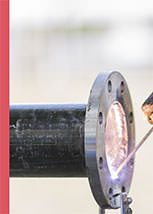
We carry out installation in accordance with the project. We manufacture measuring modules necessary for accurate and reliable accounting of thermal energy. The metering unit is a modular design, but if it is carried out with deviations from the project, then the metering device will not be able to provide correct accounting. All previous work will be in vain because this will ultimately affect the reliability of the readings of the common house meter.
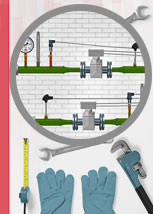
When the mounting modules are completed and cut into the existing pipelines, all couplings, threads, taps are installed and a test run of the coolant is carried out. When it is clear that the installation has been completed with high quality and there will be no more welding work, it is necessary to proceed with the installation of metering devices on the prepared straight sections (modules of metering units). Installation of a common house metering device involves the installation of 4 flow converters, temperature and pressure sensors, as well as a computer panel of the metering device.














